![[PT]](https://imgproxy.geocaching.com/fd803be3bfb7396e826555e469c7752394fb37ae?url=http%3A%2F%2Ffarm1.static.flickr.com%2F212%2F481411265_8928121d68_o.gif) A sua missão é encontrar a cache "Medieval Challenge", caso aceite vai enfrentar um desafio triplo, no qual vai testar as suas capacidades de geocacher, a sua aptidão física e a sua preparação tecnológica.
A sua missão é encontrar a cache "Medieval Challenge", caso aceite vai enfrentar um desafio triplo, no qual vai testar as suas capacidades de geocacher, a sua aptidão física e a sua preparação tecnológica.
A acção vai decorrer na Ribeira, encosta do Barredo e Sé, no coração do Porto Medieval, por entre ruelas, túneis, escadarias e demais obstáculos quer físicos quer mentais. O cansaço vai tomar conta do seu corpo e toldar-lhe a mente, o GPSr vai recusar-se a dar-lhe indicações precisas, mas acima de tudo mantenha o sangue frio e a boa disposição e vencerá.
![[EN]](https://imgproxy.geocaching.com/26dce0e20e21dd7e2c84c6c439fc1ab0a1b1385f?url=http%3A%2F%2Ffarm1.static.flickr.com%2F179%2F481411263_e6595005a4_o.gif) Your mission is to find the Medieval Challenge cache, if you choose to do it you will face a triple challenge where you will test your geocacher ability, your fitness and technological readiness.
Your mission is to find the Medieval Challenge cache, if you choose to do it you will face a triple challenge where you will test your geocacher ability, your fitness and technological readiness.
The action will take place in Ribeira, Barredo hill-side and Sé, in the heart of medieval Porto, between narrow streets, tunnels, stairways and other physical and mental obstacles. The fatigue will take care of your body and your mind will go tipsy, the GPSr will refuse to give precise information, but above all keep your mind clear and joyful and you'l win.
![[PT]](https://imgproxy.geocaching.com/fd803be3bfb7396e826555e469c7752394fb37ae?url=http%3A%2F%2Ffarm1.static.flickr.com%2F212%2F481411265_8928121d68_o.gif) Alguns factos históricos
Alguns factos históricos
A 5 de Dezembro de 1996 foi atribuído pela UNESCO ao Centro Histórico do Porto a classificação de Património Cultural da Humanidade.
A área classificada é basicamente definida pelo traçado da antiga muralha e corresponde a uma área de 90 hectares onde estão 95 edifícios de interesse patrimonial. Estão também abrangidos edifícios fora da muralha, o Mercado Ferreira Borges, a Torre dos Clérigos e o Teatro Nacional S. João. A área classificada foi ainda alargada para incluir a Ponte D. Luís I e o Mosteiro da Serra do Pilar em Vila Nova de Gaia.
Edifícios e zonas de interesse
Sé Catedral e Paço Episcopal
 Edifício construído no século XII, em estilo românico. Na torre do lado Norte um baixo relevo representando uma embarcação do século XIV simboliza a vocação marítima da cidade. A Sé recebeu importantes beneficiações no período gótico e no século XVIII. No interior destacam-se a sacristia, o claustro, a capela de João Gordo ( com um notável túmulo gótico ) a Sala do Capítulo e a exposição de Arte Sacra. As pinturas de Nicolau Nasoni, o retábulo-mor em talha dourada e o altar em prata do Santíssimo Sacramento são do período barroco.
Edifício construído no século XII, em estilo românico. Na torre do lado Norte um baixo relevo representando uma embarcação do século XIV simboliza a vocação marítima da cidade. A Sé recebeu importantes beneficiações no período gótico e no século XVIII. No interior destacam-se a sacristia, o claustro, a capela de João Gordo ( com um notável túmulo gótico ) a Sala do Capítulo e a exposição de Arte Sacra. As pinturas de Nicolau Nasoni, o retábulo-mor em talha dourada e o altar em prata do Santíssimo Sacramento são do período barroco.
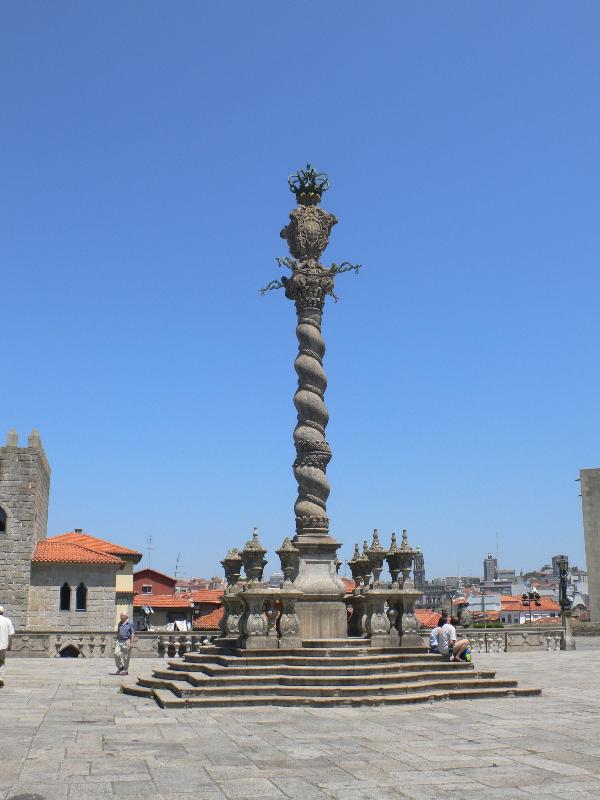 A construção do primitivo Paço remonta aos séculos XII-XIII. Foi feito de novo nos finais do século XVIII, tornando-se num dos principais palácios da cidade. O projecto é atribuído ao arquitecto Nicolau Nasoni. Nas fachadas pode apreciar-se o notável trabalho de cantaria e, no interior, a escadaria barroca e uma janela do antigo paço medieval.
A construção do primitivo Paço remonta aos séculos XII-XIII. Foi feito de novo nos finais do século XVIII, tornando-se num dos principais palácios da cidade. O projecto é atribuído ao arquitecto Nicolau Nasoni. Nas fachadas pode apreciar-se o notável trabalho de cantaria e, no interior, a escadaria barroca e uma janela do antigo paço medieval.
Torre de D. Pedro Pitões
Casa torre medieval descoberta na época das demolições do Terreiro da Sé, na década de 1940. Foi então completamente reconstruída, estando deslocada do sítio original cerca de 15 metros. Na parede norte pode ver-se um balcão em pedra de feição gótica, elemento de construção recente. Aqui esteve instalado o Gabinete de História da Cidade até 1960.
Ruína Medieval da Casa da Câmara
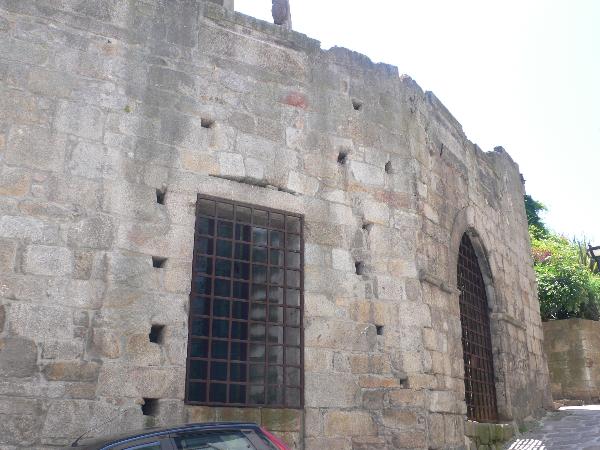 Torre construída nos séculos XIV-XV onde funcionou a Câmara Municipal até o edifício ter começado a ameaçar ruína. A entrada principal fazia-se pelo adro da Sé e era um dos edifícios mais importantes da cidade medieval. Todo em cantaria lavrada e guarnecido de merlões, tinha mais de 100 palmos de altura. Destacava-se ainda pela qualidade da obra de carpintaria e pintura no interior.
Torre construída nos séculos XIV-XV onde funcionou a Câmara Municipal até o edifício ter começado a ameaçar ruína. A entrada principal fazia-se pelo adro da Sé e era um dos edifícios mais importantes da cidade medieval. Todo em cantaria lavrada e guarnecido de merlões, tinha mais de 100 palmos de altura. Destacava-se ainda pela qualidade da obra de carpintaria e pintura no interior.
Casa Museu Guerra Junqueiro
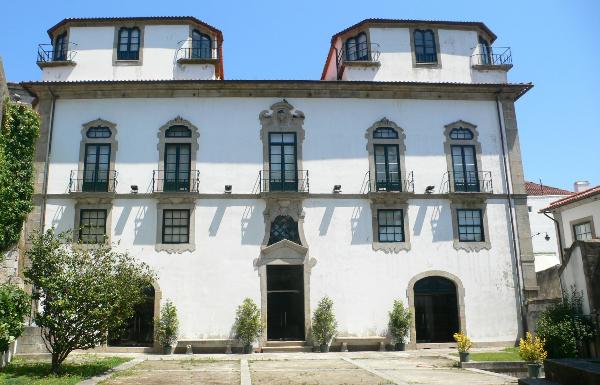 Edifício construído no século XVIII para habitação de um cónego da Sé, o Doutor Domingos Barbosa. De arquitectura barroca, o seu projecto tem sido atribuído a Nicolau Nasoni. Apresenta duas torres angulares largas e baixas, a recordar as casas quinhentistas portuguesas. Actualmente reúne as colecções de arte doadas à Câmara Municipal do Porto pelos herdeiros do poeta Guerra Junqueiro.
Edifício construído no século XVIII para habitação de um cónego da Sé, o Doutor Domingos Barbosa. De arquitectura barroca, o seu projecto tem sido atribuído a Nicolau Nasoni. Apresenta duas torres angulares largas e baixas, a recordar as casas quinhentistas portuguesas. Actualmente reúne as colecções de arte doadas à Câmara Municipal do Porto pelos herdeiros do poeta Guerra Junqueiro.
No museu destacam-se colecções de ourivesaria, escultura, cerâmica, mobiliário e tecidos.
Chafariz da Rua Escura
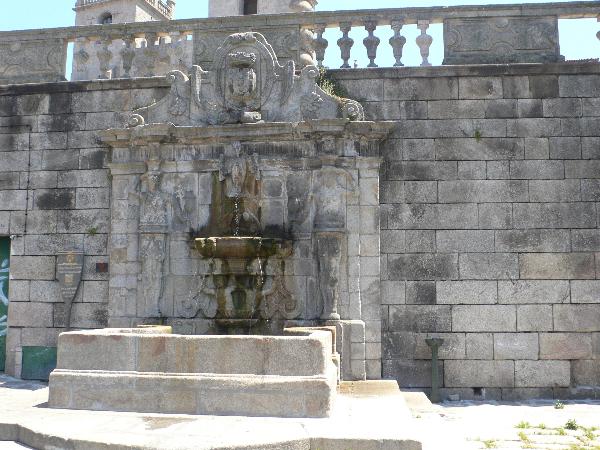 Construído no século XVII na Rua Escura, foi transferido em 1940 para o local onde actualmente se encontra. É composto por um tanque e um pano de fundo em que sobressai um pelicano ladeado por duas figuras femininas. O conjunto é encimado pelas armas reais portuguesas.
Construído no século XVII na Rua Escura, foi transferido em 1940 para o local onde actualmente se encontra. É composto por um tanque e um pano de fundo em que sobressai um pelicano ladeado por duas figuras femininas. O conjunto é encimado pelas armas reais portuguesas.
Praça da Ribeira
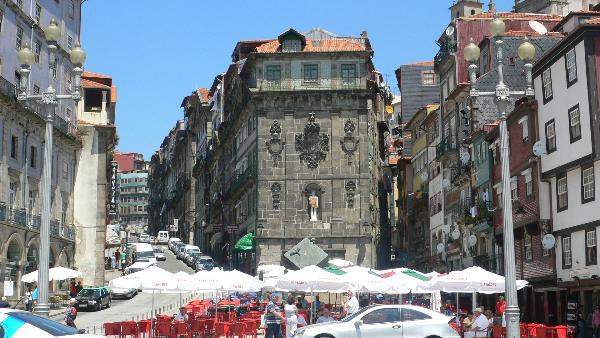 A Praça tem origem num antigo mercado medieval. Foi transformada no século XVIII, por iniciativa de João de Almada e Melo e com o apoio do cônsul inglês John Whitehead. Do novo plano apenas foram construídos os edifícios a poente, até à platibanda intermédia, e a bela fonte que serve de pano de fundo, no lado oposto ao rio. Data ainda dessa época a abertura da Rua de São João, sobre o antigo leito do Rio da Vila, para ligação à zona alta da cidade. Em 1821, foi demolido o pano da muralha fernandina que limitava a praça a Sul.
A Praça tem origem num antigo mercado medieval. Foi transformada no século XVIII, por iniciativa de João de Almada e Melo e com o apoio do cônsul inglês John Whitehead. Do novo plano apenas foram construídos os edifícios a poente, até à platibanda intermédia, e a bela fonte que serve de pano de fundo, no lado oposto ao rio. Data ainda dessa época a abertura da Rua de São João, sobre o antigo leito do Rio da Vila, para ligação à zona alta da cidade. Em 1821, foi demolido o pano da muralha fernandina que limitava a praça a Sul.
Alminhas da Ponte
Baixo relevo em bronze realizado em 1897 pelo escultor Teixeira Lopes (pai), representa a tragédia da Ponte das Barcas ocorrida no dia 29 de Março de 1809. Aquando do cerco da cidade pelas tropas francesas do Marechal Soult, centenas de populares em fuga tentaram atravessar o rio Douro lançando-se sobre a ponte, que cedeu sob o seu peso. É hoje um local de crença e devoção das gentes da Ribeira.
Torre do Barredo
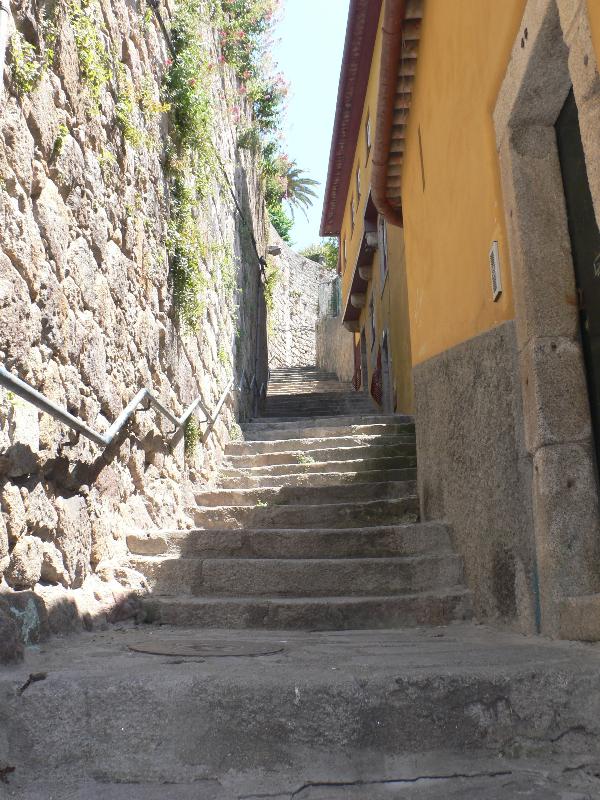 Este edifício é um dos mais antigos da cidade e o único exemplar da arquitectura civil medieval existente na zona do Barredo. É uma construção de cinco pisos, com fachadas para duas ruas, tendo no entanto um desnível de um piso. O acesso à entrada principal é feito por uma escada exterior ao edifício, como era comum na época. Apesar das transformações sofridas, esta construção poderá remontar ao século XIII, pela tipologia das janelas primitivas ainda existentes.
Este edifício é um dos mais antigos da cidade e o único exemplar da arquitectura civil medieval existente na zona do Barredo. É uma construção de cinco pisos, com fachadas para duas ruas, tendo no entanto um desnível de um piso. O acesso à entrada principal é feito por uma escada exterior ao edifício, como era comum na época. Apesar das transformações sofridas, esta construção poderá remontar ao século XIII, pela tipologia das janelas primitivas ainda existentes.
![[EN]](https://imgproxy.geocaching.com/26dce0e20e21dd7e2c84c6c439fc1ab0a1b1385f?url=http%3A%2F%2Ffarm1.static.flickr.com%2F179%2F481411263_e6595005a4_o.gif) Some historical facts
Some historical facts
On the 5th December 1996, the reward of Cultural World Heritage site by UNESCO was attributed to the Historic Centre of Oporto.
The classified area is basically defined by the old medieval wall and it corresponds to an area of 90 hectares, which harbours 95 buildings of patrimonial interest. This area also integrates some buildings that, although located out of the Wall, possess special value, such as Ferreira Borges Market, Clergymen Tower and S. João National Theatre. The classified area was still enlarged so that it could reach S. Luis Bridge and Serra do Pilar Monastery, in Vila Nova de Gaia.
Buildings and Areas of Interest
Sé Catedral (Yard of Sé)
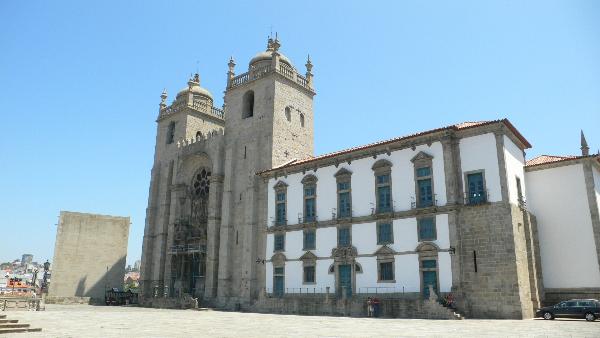 The construction of Sé do Porto dates of the 12th and 13th centuries. It is a fortified church, of romanesque structure that evidences influences of the french area of Limousin and of the school of Coimbra.
The construction of Sé do Porto dates of the 12th and 13th centuries. It is a fortified church, of romanesque structure that evidences influences of the french area of Limousin and of the school of Coimbra.
The romanesque facade of the temple is dominated by the rosy wide on the porch and sided by two towers with balconies and bulbous domes. In spite of the changes that happened above all in the 17th and 18th centuries, it maintains the imposing aspect of a fortress-church.
During the baroque period, Niccoló Nasoni drew is Loggia or Galilee (18th century) that flanks the building on the northern side.
In the interior, there are three naves, the central much higher than the lateral ones, vaulted, pointed arches, five spans, sustained by robust pillars.
The present chancel dates of the 17th century and it is a work of the Bishop D. Frei Gonçalo Morais. In the mannerist style, it replaced the primitive medieval apse.
Casa do Cabido
Casa do Cabido was built in 1582, but it was reconstructed between 1717 and 1722. The "Treasure of Sé" is exposed there and it is constituted by 150 religious ornaments, vestments, silver and liturgical books of the 15th to the 19th centuries.
To south of the Yard of Sé, we can see the Paço Episcopal, a majestic building of the late 18th century that served as Paços do Concelho. It was Bishop D. Rafael Mendonça that decided to raise the old building (whose construction goes back to the 13th century) and ordered to build a new and magnificent Paço (1734). It is the largest palace of the city. The plant belongs to Niccoló Nasoni and defines very well the style of the 18th century's civil architecture.
In the Yard of Sé, facing this architectonical group, a pillory in Manueline style with shaped column was placed there in 1945.
 Close to the Yard of Sé, in the end of the road D. Pedro Pitões, we find the Tower of the city, better known as Torre D. Pedro Pitões, discovered by the time of the Yard of Sé's demolitions, during the decade of 40. The tower was totally reconstructed, although moved from its original position, about 15 meters. It is a squared construction with two floors. In the facade turning north there is a counter in stone, of gothic feature built recently, and turning south there is an ogival door.
Close to the Yard of Sé, in the end of the road D. Pedro Pitões, we find the Tower of the city, better known as Torre D. Pedro Pitões, discovered by the time of the Yard of Sé's demolitions, during the decade of 40. The tower was totally reconstructed, although moved from its original position, about 15 meters. It is a squared construction with two floors. In the facade turning north there is a counter in stone, of gothic feature built recently, and turning south there is an ogival door.
Old House of Câmara
Scarce meters of the Sé Cathedral's north tower, at the botton of the Escadas da Rainha (Stairways), it is the Casa da Câmara, also known as Paços do Concelho or Paço da Relação. This polemic construction, by Fernando Távora, was built between 2000 and 2001 on the ruins of the original 14th, 15th centuries tower that was discovered in the forties. In the original tower, they had room sessions until the middle of the 16th century. The Casa da Câmara is also known as House of the twenty-four, because it was there that the Corporations met.
Let us go now to Rua D. Hugo, almost as old as the cathedral, where we can observe what remains of the romanesque wall and, if we want, we can go down to the riverside by the tortuous and tight stairway os Codeçal or the deep stairway of Barredo.
Proceeding through Rua D. Hugo, that surrounds the Sé Catedral, we can visit the Casa Museu Guerra Junqueiro, an old dwelling of the 18th century baroque architecture, where the collection of artistic objects belonging to the poet can be seen.
Ribeira
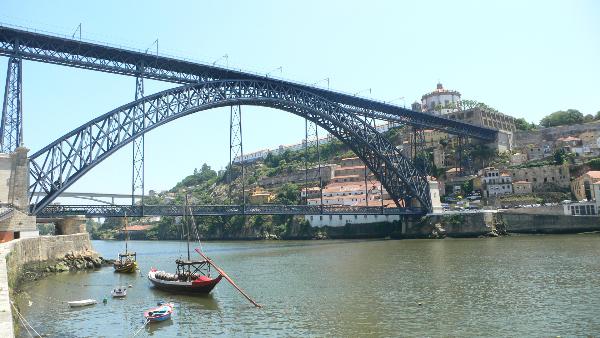 The Praça da Ribeira, is commonly called by the Portuenses as "Praça do Cubo" since the "Cubo das Pombas da Paz" (Cube of the pigeons of peace), by José Rodrigues, was placed there.
The Praça da Ribeira, is commonly called by the Portuenses as "Praça do Cubo" since the "Cubo das Pombas da Paz" (Cube of the pigeons of peace), by José Rodrigues, was placed there.
Open where formerly the most important door of the city was, it is now the centre of this area that was once so important in the development of the city, as a mercantile port.
It is perhaps the most visited part of the city, for its historical value and for the pleasent scenery that it offers. It is a picturesque place, where the fruit, vegetables and fish sale, among others, is made through the sound of the popular hawkers. This rhythm attracts plenty of curious that mix together with the inhabitants. The painter Júlio Resende knew how to portray this riverine existence in a magnificent panel of tiles of 54 m of lenght, entitled "Black Riverside" (1987), that can be seen at the entrance of Oporto, by those who come from D. Luís I Bridge.
 Through the night, the Riverside is equally, extremely lively, being a privileged place of delight for all different tastes.
Through the night, the Riverside is equally, extremely lively, being a privileged place of delight for all different tastes.
It is a square of medieval origin, transformed by João de Almada e Melo in the 18th century. Between the Praça da Ribeira and D. Luís I Bridge, a long and narrow path appears in an extensive cloth of the old Fernandin Wall, on which it is pleasant to go for a walk, enjoying the magnificent view of River Douro. Its wall is composed by a group of turn arcades and some were transformed in cellars or trade, others preserved its primitive function as means of passage into the interior alleys, that harbour some houses of Fate, lively bars and small restaurants where we can eat the typicall "Tripas à moda do Porto" grilled fish or cod.
In one of the last arcades, it is visible the terrible scene of Ponte das Barcas accident (1809) portrayed in a low-relief of brass by the sculptor Teixeira Lopes (father). This memorial is nicknamed frequently as "the Souls".
Behind we can see the Quarter of Barredo, sheer down, in a piled of high and tight houses, narrow and gloomy streets in a scenery that maintains its original medieval lines.
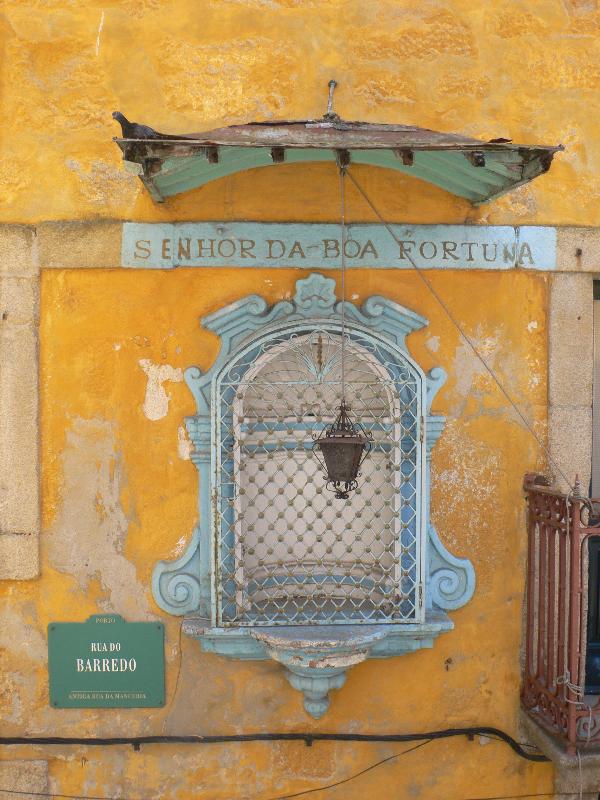 Close to D. Luis I Bridge, we can reach Sé Catedral by Escadas do Barredo (stairways) that lead to the high of the hill of Sé and for the Escadas da Verdade (stairways) that lead to Rua D. Hugo.
Close to D. Luis I Bridge, we can reach Sé Catedral by Escadas do Barredo (stairways) that lead to the high of the hill of Sé and for the Escadas da Verdade (stairways) that lead to Rua D. Hugo.
If we prefer we can continue in the Quarter of Barredo and go to Rua de Baixo, nº 5, where Tower of Barredo arises. Its construction should go back to the 13th century. It is the oldest copy of the medieval architecture in Quarter of Barredo.
![[PT]](https://imgproxy.geocaching.com/fd803be3bfb7396e826555e469c7752394fb37ae?url=http%3A%2F%2Ffarm1.static.flickr.com%2F212%2F481411265_8928121d68_o.gif) A Cache
A Cache
Mas, vamos lá começar. Está preparado? Já se deve sentir na pele de um guerreiro medieval.
A coordenada publicada vai leva-lo em frente ao belo mural criado pelo mestre Júlio Resende cujo nome é "Ribeira Negra", a primeira de uma série de caches virtuais que terá que encontrar. Está agora em condições de responder à primeira pergunta. Tem que responder a todas as perguntas para encontrar a cache final.
O caminho para a cache é pedestre e deve levar bastante água para beber, um chapeu e protector solar se necessário. Descanse de tempos a tempos, não está numa corrida.
Agora só tem que encontrar as respostas, introduzi-las nas equações e fazer as contas para ir para a etapa seguinte até chegar à cache final.
|
Para a 2ª coordenada
|
Para a 3ª coordenada
|
|
Quantas figuras humanas vê no mural "Ribeira Negra" de Resende?
Resposta: AA
Que vai substituir na seguinte expressão e calcular:
41º 08.[77 - AA]4 N
08º 36.[AA + 36]9 W
|
Quantos vestígios de arcos vê na parede de pedra?
Resposta: BB
Que vai substituir na seguinte expressão e calcular:
41º 08.[49 - BB]5 N
08º 36.[70 + BB]1 W
(Atenção: A vegetação pode estar a encobrir um dos vestígios)
|
|
Para a 4ª coordenada
|
Para a 5ª coordenada
|
|
Quantas janelas tem a fachada principal da Torre da Rua de Baixo?
Resposta: CC
Que vai substituir na seguinte expressão e calcular:
41º 08.[52 - CC]0 N
08º. 36.[CC + 68]5 W
(Se tiver dificuldade em encontrar a torre pergunte as direcções)
|
Qual os dois últimos números da data desta placa evocativa?
Resposta: DD
Que vai substituir na seguinte expressão e calcular:
41º 08.[99 - DD ]1 N
08º 36.[DD + 16]3 W
|
|
Para a 6ª coordenada
|
Para a 7ª coordenada
|
|
Quantos arcos vê aqui?
Resposta: EE
Que vai substituir na seguinte expressão e calcular:
41º 08.[55 - EE]6 N
08º 36.[EE + 63]7 W
|
Na parede com a porta num local estranho quantas janelas redondas está a ver?
Resposta: FF
Que vai substituir na seguinte expressão e calcular:
41º 08.[62 - FF]0 N
08º 36.[FF + 66]4 W
|
|
Para a Cache Final
|
| Quantas barras de ferro na vertical tem a porta?
Resposta: GG
Agora terão que utilizar todos os números que recolheram da seguinte forma:
41º 08.[AA + CC + GG + 9]2 N
08º 36.[BB + DD + EE + FF + 13]5 W
|
Divirta-se e lembre-se que algures há uma cache à sua espera, mesmo que não seja o primeiro a encontra-la.
Conteúdo inicial da cache: Logbook, stashnote, lápis, afia lápis, porta chaves para pescoço, pequenos sinos de metal.
Por favor não publique fotografias ou logs que possam revelar a localização da cache.
![[EN]](https://imgproxy.geocaching.com/26dce0e20e21dd7e2c84c6c439fc1ab0a1b1385f?url=http%3A%2F%2Ffarm1.static.flickr.com%2F179%2F481411263_e6595005a4_o.gif) The Cache
The Cache
But lets start the game, are you ready? By now you must be feeling like a medieval warrior.
The published coordinate will lead you to a beautifull mural by master Júlio Resende called Black Riverside, the first of a series of virtual caches that you must find. At this point you are ready to answer the first question. To find the final cache you must answer all the questions.
The route to the cache is pedestrian and you should take plenty of water to drink along the way, a hat and sunscreen when necessary. Rest from time to time you aren't in a race.
And now you just have to find the answers, put them in the provided equations, make some calculations and go from step to step until you reach the final cache.
|
To the 2nd coordinate
|
To the 3rd coordinate
|
|
How many human figures do you see on the mural Black Riverside from Resende?
Answer: AA
Substitute on the following expression and calculate:
41º 08.[77 - AA]4 N
08º 36.[AA + 36]9 W
|
How many arch vestiges do you see on the stone wall?
Answer: BB
Substitute on the following expression and calculate:
41º 08.[49 - BB]5 N
08º 36.[70 + BB]1 W
(Warning: The vegetation may be covering one of the vestiges)
|
|
To the 4th coordinate
|
To the 5th coordinate
|
|
How many windows has the main facade of Torre da Rua de Baixo?
Answer: CC
Substitute on the following expression and calculate:
41º 08.[52 - CC]0 N
08º. 36.[CC + 68]5 W
(If you have difficulties in finding the tower ask for directions.)
|
What are the last two numbers on the date of this evocative plate?
Answer: DD
Substitute on the following expression and calculate:
41º 08.[99 - DD ]1 N
08º 36.[DD + 16]3 W
|
|
To the 6th coordinate
|
To the 7th coordinate
|
|
How many arches do you see?
Answer: EE
Substitute on the following expression and calculate:
41º 08.[55 - EE]6 N
08º 36.[EE + 63]7 W
|
In the wall with a door in a strange place how many round windows do you see?
Answer: FF
Substitute on the following expression and calculate:
41º 08.[62 - FF]0 N
08º 36.[FF + 66]4 W
|
|
To the Final Cache
|
| How many vertical iron bars are there on this door?
Answer: GG
Now you have to use all the gathered numbers in the following way:
41º 08.[AA + CC + GG + 9]2 N
08º 36.[BB + DD + EE + FF + 13]5 W
|
Have fun and remember that somewhere there's a cache waiting for you.
Cache initial contents: Logbook, stashnote, pencil, pencil sharpener, lanyard and little metal bells.
To keep the surprise please don't publish photos or logs that might reveal the cache location.